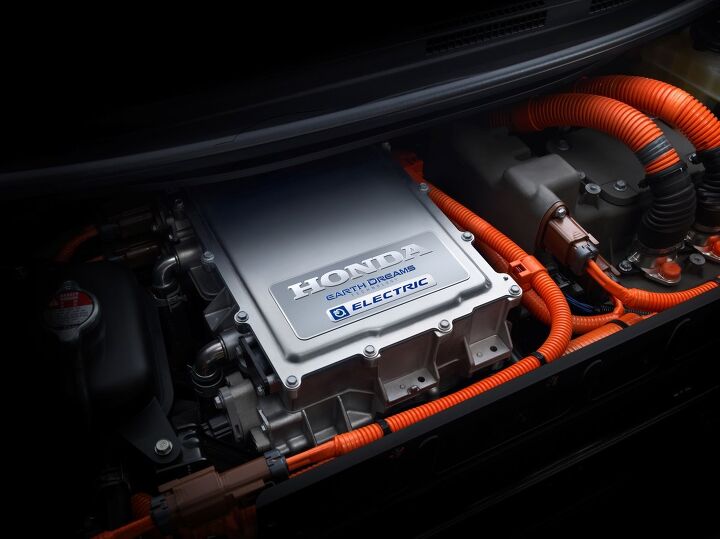Hide and Seek: Honda Clarity Electric Discontinued for 2020

Honda has discontinued sales of its Clarity EV in North America for 2020. Given that the manufacturer was one of the few OEMs to publicly express doubts about rampant electrification, this shouldn’t come as a complete surprise — with any residual shock being nullified by the model’s lackluster demand.
Between the Clarity Electric, (hydrogen) Fuel Cell, and Plug-In Hybrid models, Honda only saw 11,654 U.S. deliveries last year. That’s a marked decline against the 20,000 units sold in 2018 and a hint as to why the EV has been quietly put out to pasture. Most of those sales undoubtedly went to the nationally available Clarity Hybrid. Fueling restrictions have locked the hydrogen variant to California, with the Electric similarly being isolated to the Golden State and Oregon (the Beaver State).
According to Green Car Reports, Honda confirmed that it abandoned the car at the start of this year. It also removed the Clarity Electric from its consumer sites in Japan and Canada. That leaves the company with no battery-only offerings until the Honda E arrives in Europe and Japan this summer. While originally planned for North America as well, the business ultimately decided the electric city car wasn’t suited for the market — something that might also have been true for the Clarity.
Drivers on this continent tend to cover more ground in a single trip, making range anxiety a serious issue for prospective EV buyers. The Clarity attempted to get around this with relatively swift recharging times. With help from DC fast-charging ports, Honda said the Electric could recoup 80 percent of its maximum charge in just 30 minutes. The model’s 25.5-KWh battery was also extremely efficient for its size, but positively microscopic when compared to the packs found in other EVs. As a result, the Clarity’s official range was only 89 miles.
While a relative bargain at just $199 per month with less than a grand down for a three-year lease, the Clarity Electric’s abysmal range pigeonholed it as an urban commuter. Lacking versatility, we imagine a lot of customers opted for the Hybrid or took their money elsewhere. But don’t take this as a signal that Honda is getting out of the EV market. The Clarity always seemed like an attempt to test various powertrain types on the public, rather than a serious attempt to draw in new customers.
The company has said it intends to make the majority of its vehicle electrified (at least to some degree) by 2030. However, this might not look exactly the same as what other manufacturers are proposing. While many automakers are scaling down displacement as they hunt for a way to supplant BEVs as the dominant vehicle type, Honda has been adamant that consumers will only care about the resulting efficiencies stemming from battery tech. From a corporate standpoint, its singularly interested in maximizing fuel economy.
That mindset has encouraged the automaker to remain focused on hybridization and further improving internal combustion engines, rather than sinking its wealth into battery development. Honda CEO Takahiro Hachigo has also said that complicating the customer experience with long charging times isn’t desirable. He believes electrification has to broadly benefit the user experience to hold any real value and worries that the slow take rate of many EVs is the direct result of this being ignored. By staying with hybrids, Honda thinks it can cater to the environmental regulations of multiple markets without having to stick out its neck to fickle consumers.
[Images: Honda]

A staunch consumer advocate tracking industry trends and regulation. Before joining TTAC, Matt spent a decade working for marketing and research firms based in NYC. Clients included several of the world’s largest automakers, global tire brands, and aftermarket part suppliers. Dissatisfied with the corporate world and resentful of having to wear suits everyday, he pivoted to writing about cars. Since then, that man has become an ardent supporter of the right-to-repair movement, been interviewed on the auto industry by national radio broadcasts, driven more rental cars than anyone ever should, participated in amateur rallying events, and received the requisite minimum training as sanctioned by the SCCA. Handy with a wrench, Matt grew up surrounded by Detroit auto workers and managed to get a pizza delivery job before he was legally eligible. He later found himself driving box trucks through Manhattan, guaranteeing future sympathy for actual truckers. He continues to conduct research pertaining to the automotive sector as an independent contractor and has since moved back to his native Michigan, closer to where the cars are born. A contrarian, Matt claims to prefer understeer — stating that front and all-wheel drive vehicles cater best to his driving style.
More by Matt Posky
Latest Car Reviews
Read moreLatest Product Reviews
Read moreRecent Comments
- Redapple2 Dear lord ! That face. HARD NO.
- Urlik Let’s ban for all. Having that data anywhere leaves it open to the Chinese government potentially hacking systems to get the data.
- Redapple2 Gen 1 - 8/10 on cool scale.Gen 2 - 3/10.
- SCE to AUX "...to help bolster job growth and the local economy"An easy win for the politicians - the details won't matter.
- Kjhkjlhkjhkljh kljhjkhjklhkjh so now we will PAY them your tax money to build crappy cars in the states ..




































Comments
Join the conversation
1. Range sucks; but more importantly 2. This car is hideous looking. Matches the Prius for "bastard step-child" status.
Need to start with a clean sheet to design an optimum EV. Not just shove batteries in a ICE car.